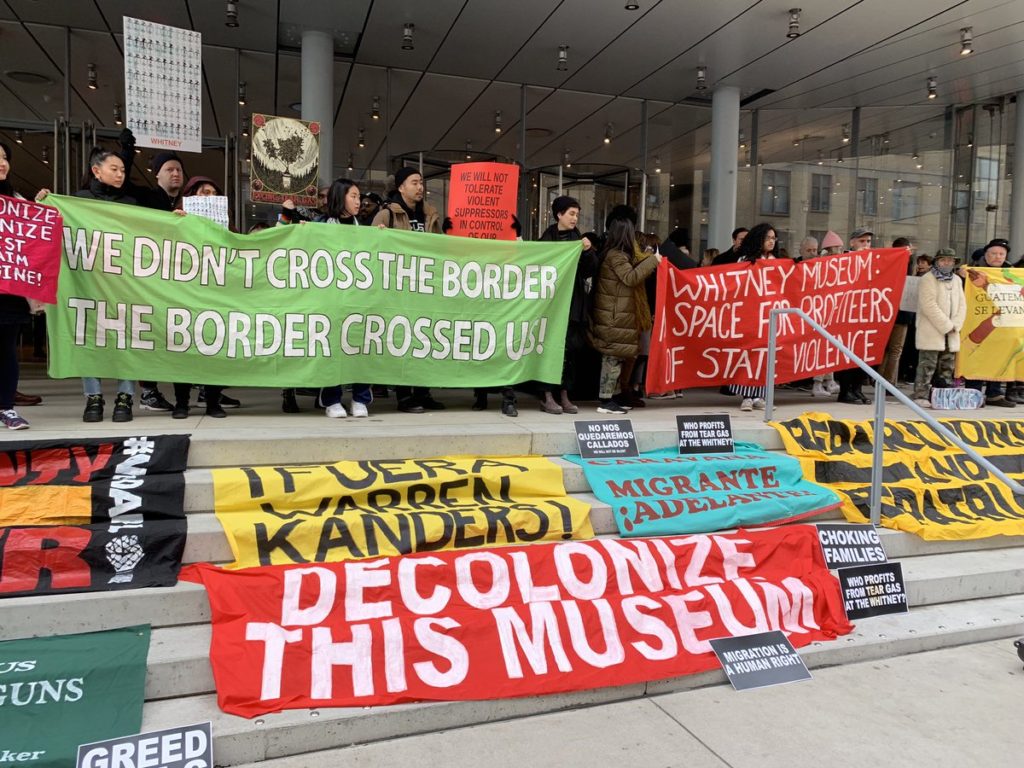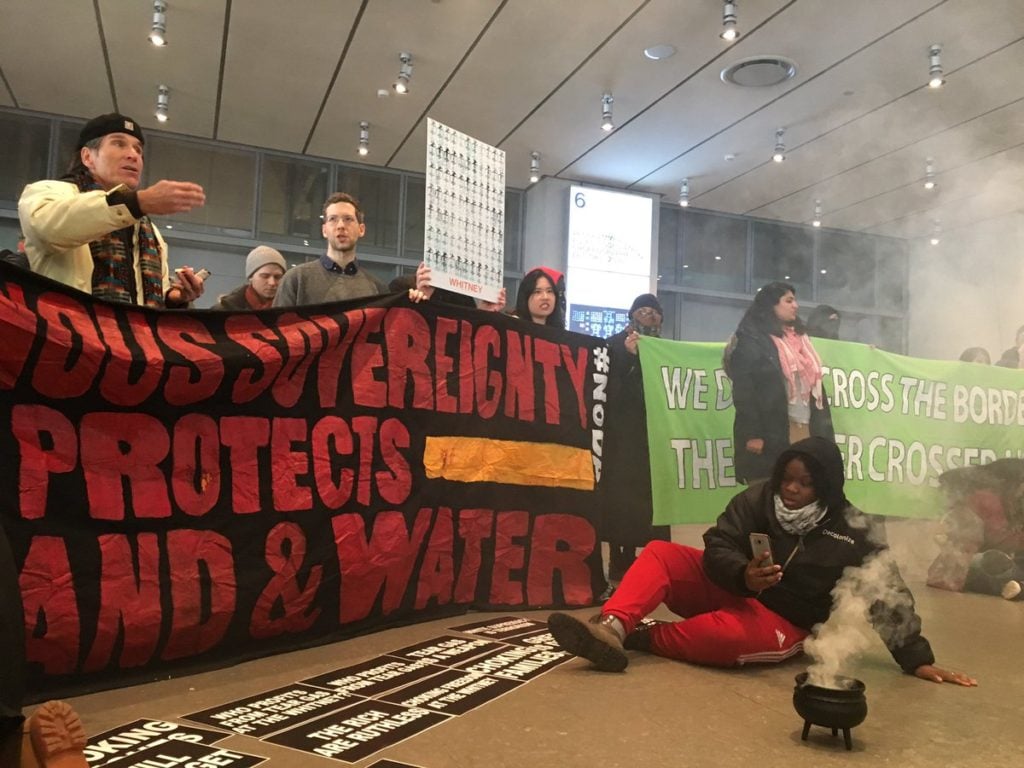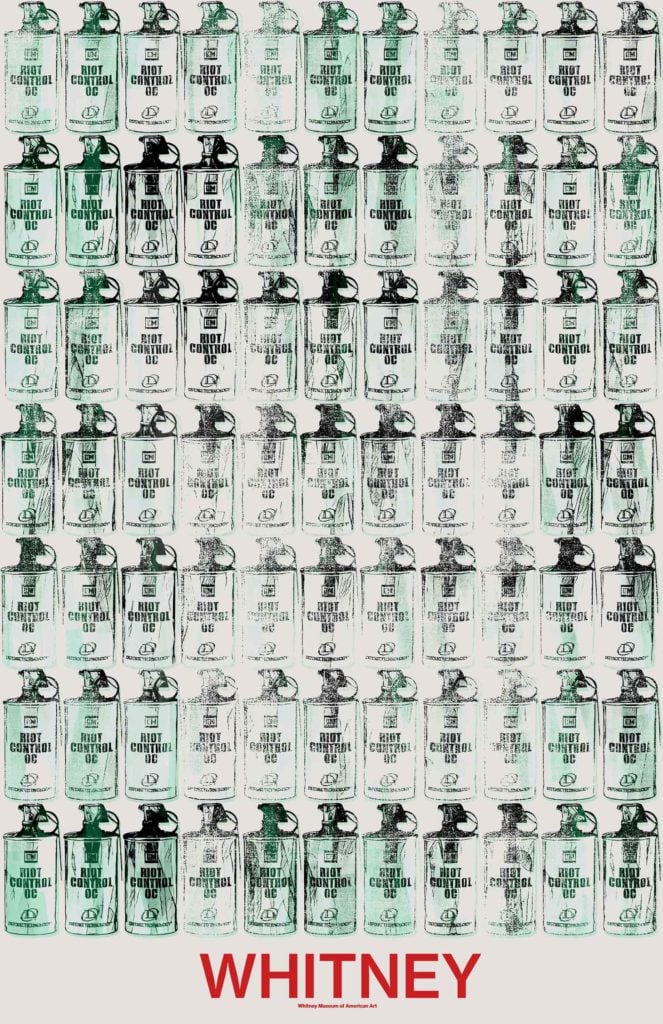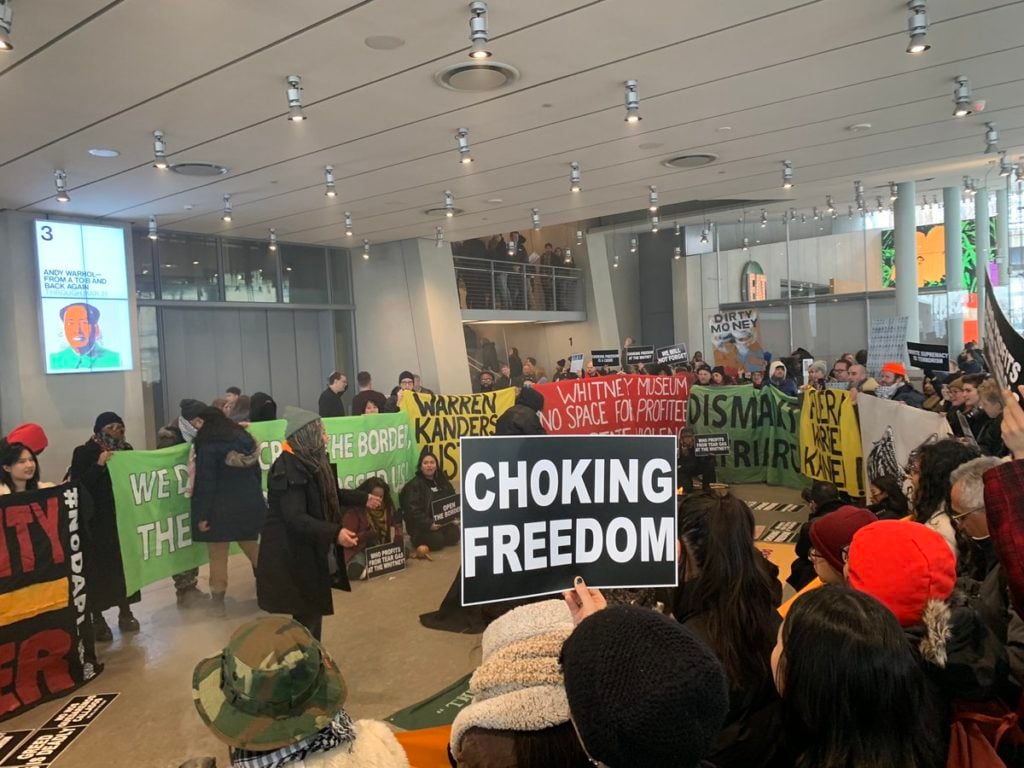Politics
Demonstrators Fill the Whitney Museum—and Burn Sage—to Protest Its Vice Chairman’s Ties to Tear Gas Manufacturer
Decolonize This Place and other activist groups brought banners and chants to the Whitney Museum this weekend.

Decolonize This Place and other activist groups brought banners and chants to the Whitney Museum this weekend.

A protest at New York’s Whitney Museum of American Art saw the fire department called to the scene yesterday. The museum’s lobby was filled with smoke from demonstrators burning sage, a symbolic action meant to mirror the toxic tear gas used on November 25 against asylum seeks attempting to enter the US from Mexico.
The protest began at noon on Sunday and included speeches, chanting, and music. “Against the toxic clouds produced by Safariland, we burn sage. Smoke that protects and heals, smoke that remembers and honors, smoke that chokes the powerful but smells sweet to us as we assemble for freedom and dignity,” wrote Decolonize This Place in a statement prepared ahead of the action.
The protest is the most visible and public demonstration to date in an ongoing debate over the presence of Warren B. Kanders, the owner of the company Safariland, on the museum’s board. The flurry of discussion and criticism began on November 27, when an article on Hyperallergic publicized the ties between Kanders, the Whitney’s board vice chair, and Safariland, which manufactured the tear gas used by United States Customs and Border Protection officers on migrant mothers and children at the San Diego-Tijuana border. Kanders has served as Safariland’s board chairman since 1996 and owner since 2012.
The Sunday demonstration against Kanders’s continued presence on the institution’s board, led by the activist group Decolonize This Place, was held in conjunction with a coalition of other New York City groups. It is one of a growing number of protests drawing attention to unsavory sources of museum funding, from photographer Nan Goldin’s campaign against museums that accept funding from the Sackler family to environmentalists’ demonstrations against museums funded by BP and other oil companies.

Decolonize This Place protests at the Whitney Museum of American Art. Photo courtesy of @subasu.
This wasn’t the only protest against Kanders targeting the Whitney this week, either. A second, unaffiliated protest action took place on Monday morning, led by artist Rafael Shimunov. Together with the group Art V War, he created a guerrilla-style installation of a painting based on a photo taken at the border last month of a mother and her two young children running from tear gas.
He labeled the work, Mother and her daughters in tear gas (2018) and credited “Whitney Vice Chair, Warren Kanders in collaboration with Trump” as the artist. The artist posted footage of himself installing the work and an accompanying label on a wall on the east side of the Whitney’s galleries earlier today. Shimunov has also launched a Color of Change petition calling for Kanders’s resignation.
The protesters noted that they were acting separately, but in solidarity with, the staff of the Whitney Museum. Around a week and a half ago, nearly 100 museum employees wrote a letter calling for Kanders to be removed from the board and for the museum to release a statement acknowledging the issue. (Kanders is also a “significant contributor” to the Whitney’s “Andy Warhol: From A to B and Back Again,” according to the exhibition credits.)
In addition to handmade posters carried by demonstrators, the Sunday protest also included imagery in the style of Warhol’s art and museum publicity materials, created by Decolonize This Place and the collective MTL+.

Protest imagery created by Decolonize This Place and the MTL+ in the style of Andy Warhol. Courtesy of Decolonize This Place and the MTL+.
Mimicking the Pop art great’s multicolored screen prints, the artworks feature rows of tear gas canisters (instead of Campbell’s soup), and photographs of activists being gassed at Standing Rock and of Weinberg and Kanders smiling at a museum gala.
“The immediate goal is that Warren Kanders must go,” Marz Saffore, a member of Decolonize This Place, told Hyperallergic, adding that even if that happens, there are still “dozens and dozens of other issues within the board of trustees at the Whitney.”
Half an hour into this #DecolonizeThisPlace protest in the @whitneymuseum lobby, no signs of slowing down. (Organizers brought their own instruments.) pic.twitter.com/0S8Iz5ZDbS
— Shumita Basu (@shubasu) December 9, 2018
Following the firefighters’ arrival, the protest moved outside and continued peacefully, with flyers explaining the situation being handed out to museum visitors and passersby. Banners reading “WHITNEY MUSEUM: NO SPACE FOR PROFITEER OF STATE VIOLENCE” amplified the message.
“Museum visitors seemed to be equally divided along lines of befuddled incomprehension and genuine curiosity about the protest,” said artist William Powhida, who participated in the demonstration. “I was approached a few times to answer peoples’ questions and it seemed to me that there is very little public awareness about who Warren B. Kanders is and what his company, Safariland, does.”

Decolonize This Place protests at the Whitney Museum of American Art. Photo courtesy of @nycDSAantiwar.
In response to the uproar last week, museum director Adam Weinberg issued a letter reiterating what he views as the museum’s role as a bastion of progressive art, a place for open discussion about difficult subjects, and a venue where underrepresented voices can be heard. In the letter, which did not mention Kanders by name, Weinberg also noted that “trustees do not hire staff, select exhibitions, organize programs or make acquisitions, and staff does not appoint or remove board members.”
Soon after, the embattled vice chair himself issued a statement noting that he had no control over how Safariland products were deployed. “I think it is clear that I am not the problem the authors of the letter seek to solve,” Kanders wrote.
Weinberg’s “tepid response to the staff letter” was a big reason Powhida decided to take part in the protest, he said. “The Whitney is one of the most visible contemporary arts museums in the country and I don’t think it should be used—as an institution that is seeking to represent diversity—to art wash or launder the reputation of Kanders,” he told artnet News in an email. “If an artist has a platform and an audience, I think we have a responsibility to amplify messages of groups like Decolonize This Place.”

Protest imagery created by Decolonize This Place and the MTL+ in the style of Andy Warhol. Courtesy of Decolonize This Place and the MTL+.
It appears the group’s campaign is far from over. “We do not do one-offs,” Decolonize This Place told artnet News in a Facebook message. “But we are also waiting to hear how the Whitney will respond after our action, and whether they will remove Warren B. Kanders.”
As of press time, the Whitney had not responded to artnet News’s request for comment.